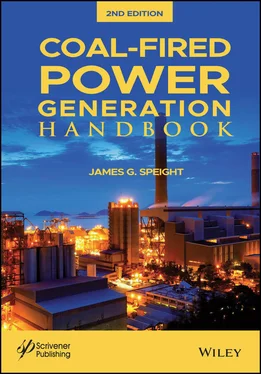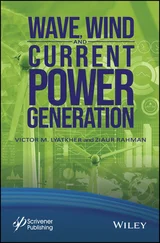Table 1.3 History of coal use.
| Time frame |
Use |
| Stone Age |
Coal may have been used for heating and cooking. |
| AD 100-200 |
The Romans use coal for heating. |
| 1300s |
In the American southwest, Hopi Indians use coal for heating. |
| 1673 |
Explorers to America discover coal. |
| 1700s |
The English find coal produces a fuel that burns cleaner and hotter than wood charcoal. |
| 1740s |
Commercial coal mines begin operation in Virginia. |
| 1800s |
James Watt invents the steam engine and uses coal to produce the steam to run the engine. The Industrial Revolution spreads to the United States as steamships and steam-powered railroads become the main forms of transportation, using coal to fuel their broilers. During the Civil War, weapons factories begin using coal. By 1875, coke replaces charcoal as the primary fuel for iron blast furnaces to make steel. 1880s: Coal is first used to generate electricity for homes and factories. |
| 1900s |
Coal accounts for more than three-quarters of the total energy used in the United States, but is later supplanted by oil and natural gas for transportation and residential applications. Coal reemerges later as an affordable, abundant domestic energy resource to support the growing demand for electricity. In the late 1900s, environmental issues force a reduction in the amount of coal used for power generation. Clean Coal technologies were developed in the United States to allow coal to be used in an environmentally friendly manner. |
The Somerset coalfield included pits in the north Somerset, England, area where coal was mined from the 15 thcentury until 1973. It is part of a wider field which covered northern Somerset and southern Gloucestershire in England. There is documentary evidence of coal being dug from this coalfield in the 14 thcentury and continuing until the 16 thcentury. During the early part of the 17 thcentury coal was largely obtained by excavating the outcrops or driving an incline, which involved following the seam into the ground. Only a small amount of coal could be obtained by these methods and so bell pits took their place – a bell pit is so-named because in cross section the pit resembles an upturned bell. The bell pit is a primitive method of mining coal where the coal lies near the surface on flat land. A shaft is sunk to reach the coal which is then excavated and removed by means of a bucket (much like a well). No supports are used and mining continues outward until the mine becomes too dangerous (or collapses) at which point another mine is started.
Mineral coal came to be referred to as sea coal (seacoal), probably because it came to many places in eastern England, including the northeast coast 50 to 100 miles south of the Scottish border. This is accepted as the more likely explanation for the name of the coal, having fallen from the exposed coal seams above or washed out of underwater coal seam outcrops. These easily accessible sources had largely become exhausted (or could not meet the growing demand) by the 13 thcentury when underground mining from shafts or adits was developed. An alternative name was pit coal (pit coal), because it came from mines. It was, however, the development of the Industrial Revolution (18 thcentury to 19 thcentury) that led to the large-scale use of coal, as the steam engine took over from the water wheel. Looked at from another angle, the Industrial Revolution was impossible without coal.
Currently, in the United States, coal is used primarily to generate electricity. The coal is burned in power plants to produce almost 40% of the electricity that is used each year. Coal is also used in the industrial and manufacturing industries. For example, the steel industry uses large amounts of coal – the coal is baked in hot furnaces to make coke, which is used to smelt iron ore into the iron needed for making steel. The high temperatures created from the use of coke gives steel the strength and flexibility needed for making bridges, buildings, and automobiles. The heat and the by-products produced from coal are also used to produce a variety of products such as methanol (methyl alcohol, CH 3OH) and ethylene (CH 2=CH 2) which can then be used to produce plastics, synthetic fibers, fertilizers, and medicines.
Certain characteristics of coal ensure its place as an efficient and competitive energy source and contribute to stabilizing energy prices. Key factors include (i) the large reserves without associated geopolitical or safety issues, (ii) the availability of coal from a wide variety of sources, (iii) the facility with which coal can be stored in normal conditions, and (iv) the non-special and relatively inexpensive protection required for the main coal supply routes. Furthermore, retirements of older units, retrofits of existing units with pollution controls, and the construction of some new coal-fueled units are expected to significantly change the coal-fueled electricity generating fleet, making it capable of emitting lower levels of pollutants than the current fleet but reducing its future electricity generating capacity (GAO, 2012).
Deposits of coal, sandstone, shale, and limestone are often found together in sequences hundreds of feet thick. This period is recognized in the United States as the Mississippian and Pennsylvanian time periods due to the significant sequences of these rocks found in those states (i.e., Mississippi and Pennsylvania) ( Table 1.4). Other notable coal-bearing ages are the Cretaceous, Triassic and Jurassic Periods. The more recently aged rocks are not as productive for some reason, but lignite and peat are common in younger deposits but generally, the older the deposit, the better the grade (higher rank) of coal (Ward, 2008).
As with many industrial minerals, the physical and chemical properties of coal beds are as important in marketing a deposit as the grade . The grade of a coal establishes its economic value for a specific end use. Grade of coal refers to the amount of mineral matter that is present in the coal and is a measure of coal quality. Sulfur content; ash fusion temperatures, i.e., measurement of the behavior of ash at high temperatures; and quantity of trace elements in coal are also used to grade coal. Although formal classification systems have not been developed around grade of coal, coal grade is important to the coal user.
Table 1.4 The Geologic timescale.
| Era |
Period |
Epoch |
Duration (x 106) |
Years ago (x 106) |
| Cenozoic |
Quaternary |
Holocene |
10,000 ** |
|
| Pleistocene |
2 |
.01 |
| Tertiary |
Pliocene |
11 |
2 |
| Miocene |
12 |
13 |
| Oligocene |
11 |
25 |
| Eocene |
22 |
36 |
| Paleocene |
10 |
58 |
| Mesozoic |
Cretaceous |
|
71 |
65 |
| Jurassic |
|
57 |
136 |
| Triassic |
|
35 |
190 |
| Paleozoic |
Permian |
|
50 |
225 |
| Carboniferous |
|
65 |
280 |
| Devonian |
|
60 |
345 |
| Silurian |
|
25 |
405 |
| Ordovician |
|
65 |
425 |
| Cambrian |
|
70 |
500 |
| Precambrian |
|
|
3,400 |
600 |
Approximate
Читать дальше












